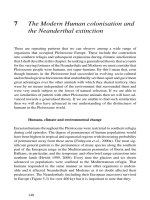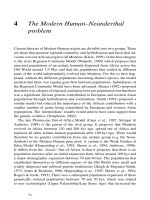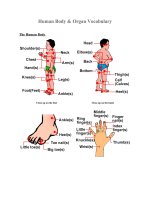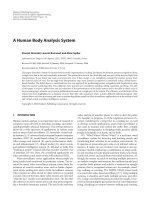the amazing human body nervous system
Bạn đang xem bản rút gọn của tài liệu. Xem và tải ngay bản đầy đủ của tài liệu tại đây (12.16 MB, 81 trang )
1st Proof Title: The Amazing Human Body 2-Nervous System : 28147
THE AMAZING HUMAN BODY
NERVOUS
SYSTEM
GEORGE CAPACCIO
nervousint_.indd 1nervousint_.indd 1 8/26/09 9:35:29 AM8/26/09 9:35:29 AM
Job No: CPL809-99/3184
2nd Proof Title: The Amazing Human Body 2-Nervous System : 28147
Job No: CPL909-20/4028
Marshall Cavendish Benchmark
99 White Plains Road
Tarrytown, New York 10591
www.marshallcavendish.us
Text copyright © 2010 by Marshall Cavendish Corporation
All rights reserved. No part of this book may be reproduced or utilized in any form or by any
means electronic or mechanical including photocopying, recording, or by any information storage
and retrieval system, without permission from the copyright holders.
All websites were available and accurate when this book was sent to press.
Editor: Karen Ang
Publisher: Michelle Bisson
Art Director: Anahid Hamparian
Series Design by: Kay Petronio
Series Designer: Elynn Cohen
Library of Congress Cataloging-in-Publication Data
Capaccio, George.
The nervous system / by George Capaccio
p. cm. (The amazing human body)
Includes bibliographical references and index.
Summary: “Discusses the parts that make up the human nervous system, what can go wrong, how to treat those ill-
nesses and diseases, and how to stay healthy” Provided by publisher.
1. Nervous system Juvenile literature. 2. Nervous system Diseases Juvenile literature. I. Title.
QP361.5.K56 2010 612.8 dc22 2008037255
Front cover: The brain and the spinal cord Back Cover: Nerve cells
Photo research by Tracey Engel
Front cover photo: Derek Berwin / Getty
The photographs in this book are used by permission and through the courtesy of: Getty Images: Dr. Fred Hossler, 1;
3D4Medical.com, 4, 7, 17, 38; Dennis Kunkel Microscopy, Inc., 6; 3D Clinic, 9, 18, 58; CMSP, 23, back cover; De Agostini,
10, 14, 19; Dr. David M. Phillips, 12; Scientifica, 13; artpartner-images, 16; Carol and Mike Werner/Visuals Unlimited, Inc.,
20; Barbara Singer, 22; Nucleus Medical Art, Inc., 24, 27, 29, 35, 36, 40, 55, 59, 65; James Worrell, 26; Dr. John D. Cunning-
ham/Visuals Unlimited, Inc., 43; Jeff Sherman, 45; Nick Veasey, 51; George Musil, 60; Barros & Barros, 62; Karen Knauer,
64; Patryce Bak, 67; Zia Soleil, 69; Philip Lee Harvey, 70; Jamie Grill, 71; B Busco, 72. Alamy: Scott Camazine, 46; Nucleus
Medical Art, Inc., 50, 53; Jupiter Images/Comstock Images, 54; Collection CNRI / PHOTOTAKE, 56. Photo Researchers, Inc.:
BSIP, 31, 41. James Cavallini, 32; Gary Carlson, 48. SuperStock: Image Source, 28.
Printed in Malaysia
1234 5 6
= nerve cells from the brain stem
This book is not intended for use as a substitute for advice, consultation, or treatment by a licensed medical practitioner.
The reader is advised that no action of a medical nature should be taken without consultation with a licensed medical
practitioner, including action that may seem to be indicated by the contents of this work, since individual circumstances
vary and medical standards, knowledge, and practices change with time. The publisher, author, and medical consultants
disclaim all liability and cannot be held responsible for any problems that may arise from use of this book.
nervousint_.indd 2nervousint_.indd 2 9/7/09 9:25:20 PM9/7/09 9:25:20 PM
ISBN 978-0-7614-4489-3
1st Proof Title: The Amazing Human Body 2-Nervous System : 28147
Job No: CPL809-99/3184
CHAPTER 1
What Is the Nervous System? . . . . . . . . . . . . 5
CHAPTER 2
How Does the Nervous System Work? . . 21
CHAPTER 3
Diseases and Disorders. . . . . . . . . . . . . . . . 47
CHAPTER 4
A Healthy Nervous System . . . . . . . . . . . . . 63
GLOSSARY . . . . . . . . . . . . . . . . . . . . . . . . . . .73
FIND OUT MORE . . . . . . . . . . . . . . . . . . . . . . .76
INDEX . . . . . . . . . . . . . . . . . . . . . . . . . . . . . .78
CONTENTS
nervousint_.indd 3nervousint_.indd 3 8/26/09 9:35:38 AM8/26/09 9:35:38 AM
1st Proof Title: The Amazing Human Body 2-Nervous System : 28147
Job No: CPL809-99/4028
nervousint_.indd 4nervousint_.indd 4 8/26/09 4:29:54 PM8/26/09 4:29:54 PM
5
1st Proof Title: The Amazing Human Body 2-Nervous System : 28147
Job No: CPL809-99/3184
T
he nervous system is responsible for all the processes that
make human life possible. It lets us think, dream, and have a lifetime
of memories. It also handles our most basic, involuntary actions
and reactions like blinking our eyes, keeping our body at the right
temperature, breathing, and making our heart beat. It is the body’s
way of communicating with itself and the outside world.
The human nervous system can be divided into two separate
systems—the central nervous system (CNS) and the peripheral nervous
system (PNS). The central nervous system includes the brain and the
spinal cord. The peripheral nervous system is everything else. This
What Is the
Nervous System?
The human nervous system is made up of the brain, the spinal cord,
and the networks of nerves running throughout the body.
1
nervousint_.indd 5nervousint_.indd 5 8/26/09 9:35:51 AM8/26/09 9:35:51 AM
NERVOUS SYSTEM
6
1st Proof Title: The Amazing Human Body 2-Nervous System : 28147
Job No: CPL809-99/3184
“everything else” includes all the nerves that connect the central nervous
system with the muscles, glands, and organs of our bodies.
THE BRAIN
An adult brain weighs about 3 pounds (1.4 kilograms). It is roughly the
size of a large grapefruit and kind of looks like a cauliflower. The human
brain is probably the most complex organ in the body.
It has about 100 billion nerve cells, or neurons, and trillions of
support cells called glia. If you could remove all 100 billion nerve cells
and arrange them in a straight line, they would stretch for a distance of
about 600 miles (1,000 kilometers). Of course, you would not be able to
see this line since nerve cells are only visible under a microscope. Many
scientists think that if you tried to count all of the neurons in the human
brain, it would take you more than three thousand years.
The activities of the billions of nerve cells in the brain are responsible for many of the
important processes in the body.
nervousint_.indd 6nervousint_.indd 6 8/26/09 9:36:01 AM8/26/09 9:36:01 AM
7
What Is the Nervous System?
1st Proof Title: The Amazing Human Body 2-Nervous System : 28147
Job No: CPL809-99/3184
nervousint_.indd 7nervousint_.indd 7 8/26/09 9:36:16 AM8/26/09 9:36:16 AM
NERVOUS SYSTEM
8
1st Proof Title: The Amazing Human Body 2-Nervous System : 28147
Job No: CPL809-99/3184
THE SPINAL CORD
The spinal cord is a long, bundle of nerves that carries nerve impulses
back and forth between the brain and the rest of the body. It is about 17
inches (43 centimeters) long in women and 18 inches (45 cm) in men. It is
about .5 inch (1.3 cm) wide.
The top of the spinal cord connects with the base of the brain at
the brain stem. The lower end of the spinal cord is about two-thirds of the
way down the spinal column. The spinal cord is safely contained within
the spinal column, which is also called the spine or the vertebral column.
The spine is made up of thirty-three bones called vertebrae. Each vertebra
is separated from the one above and the one below by a disc of flexible,
shock-absorbent tissue called cartilage. The spinal column is an important
part of the body’s skeletal system. It supports the skull and connects with
the hips.
The spinal cord has thirty-one pairs of spinal nerves. With the
exception of the top pair of nerves, the spinal nerves exit the spinal
column through the spaces between the vertebrae. Spinal nerves conduct
information to and from the spinal cord to the rest of the body.
THE PERIPHERAL NERVOUS SYSTEM
The peripheral nervous system is made up of all the nerves outside the
central nervous system. These include the nerves that leave the brain
and the spinal cord and extend to all parts of the body. Part of the job
of the peripheral nervous system is to gather information from sensory
receptors and relay, or send out, this information to the central nervous
system. The messages are transmitted in the form of electrical signals, or
nerve impulses.The central nervous system then interprets the messages
it receives and sends out the appropriate responses to the body’s glands,
muscles, and organs.
nervousint_.indd 8nervousint_.indd 8 8/26/09 9:36:19 AM8/26/09 9:36:19 AM
9
1st Proof Title: The Amazing Human Body 2-Nervous System : 28147
Job No: CPL809-99/3184
The spinal cord starts at the base of the brain and stretches down to the bottom of the spine.
nervousint_.indd 9nervousint_.indd 9 8/26/09 9:36:20 AM8/26/09 9:36:20 AM
NERVOUS SYSTEM
10
1st Proof Title: The Amazing Human Body 2-Nervous System : 28147
Job No: CPL809-99/3184
Scientists have come up with different ways of classifying the
various parts of the peripheral nervous system. One way is to break it
down into a sensory nervous system and a motor nervous system. The
sensory nervous system carries information from sensory receptors to the
central nervous system. The motor nervous system gathers information
Nerves (blue and green) stretch throughout the body to connect the different organs
and glands to the brain and spinal cord.
nervousint_.indd 10nervousint_.indd 10 8/26/09 9:36:33 AM8/26/09 9:36:33 AM
11
What Is the Nervous System?
1st Proof Title: The Amazing Human Body 2-Nervous System : 28147
Job No: CPL809-99/3184
from the central nervous system and relays it to the appropriate organs
and muscles.
The motor nervous system can be further divided into the autonomic
and the somatic nervous systems. The autonomic system is also called the
involuntary nervous system. It is responsible for all those movements and
activities we have no conscious control over. This includes activities like
sweating when we are hot or shivering when we are cold.
The somatic, or voluntary nervous system, handles those movements
we consciously decide to make. Getting out of bed in the morning,
running down the football field for a touchdown, or playing a video game
are activities that require conscious choice. Our somatic nervous system
makes it possible for us to make such choices in order to move our bodies
in certain ways.
NEURONS
Our body is made up of many different kinds of cells. Each type has its
own unique function or purpose. Most cells are microscopic in size, which
means they can only be seen with the aid of a microscope. Neurons are
the most basic part of the nervous system. A neuron is a nerve cell. Nerve
cells are highly specialized cells, and are different from all the other cells
in our bodies.
Neurons are the only cells in the human body that can send
“messages” from part of the body to another part. These messages are
in the form of electrochemical changes. In other words, nerve cells can
communicate with each other. This exchange of information results
in either voluntary or involuntary actions in our muscles, glands,
and organs.
Many neurons look like squashed stars that have been stretched in
different directions. While there is much variety in the size and shape of
nervousint_.indd 11nervousint_.indd 11 8/26/09 9:36:43 AM8/26/09 9:36:43 AM
NERVOUS SYSTEM
12
1st Proof Title: The Amazing Human Body 2-Nervous System : 28147
Job No: CPL809-99/3184
nervousint_.indd 12nervousint_.indd 12 8/26/09 9:36:44 AM8/26/09 9:36:44 AM
13
1st Proof Title: The Amazing Human Body 2-Nervous System : 28147
Job No: CPL809-99/3184
neurons, all nerve cells have certain characteristics in common. They have
a central part called a nucleus. The parts that extend from the nucleus
are the axons and dendrites. Axons carry information—in the form of
an electrical signal—away from the neuron to another neuron. Dendrites
receive electrical signals from other neurons.
A typical neuron is about 10 microns wide, which is smaller than
a period at the end of a sentence or the dot on top of a small letter “i.”
Though they are not very wide, neurons are the longest cells in the human
body. The axon a neuron in the spinal cord that connects to a foot muscle
can be about 3 feet (1 meter) long. Nerves are thin threads of neurons.
These nerves create a kind of electrical circuitry in the body. Without
it, we could not feel or respond to changes inside our body and in the
world outside.
All neurons, or nerve cells, have a main cell body and long extensions called axons and dendrites.
nervousint_.indd 13nervousint_.indd 13 8/26/09 9:36:48 AM8/26/09 9:36:48 AM
NERVOUS SYSTEM
14
1st Proof Title: The Amazing Human Body 2-Nervous System : 28147
Job No: CPL809-99/3184
Some nerves control voluntary actions, such as moving the arm, while others assist the body in
involuntary actions that support life.
nervousint_.indd 14nervousint_.indd 14 8/26/09 9:37:01 AM8/26/09 9:37:01 AM
15
What Is the Nervous System?
1st Proof Title: The Amazing Human Body 2-Nervous System : 28147
Job No: CPL809-99/3184
There are different types of neurons. One way to classify
neurons is by the number of extensions they have. Another way is by
the direction in which the neurons send information. Motor, or efferent,
neurons send information away from the central nervous system toward
muscles and glands. Sensory, or afferent, neurons send information from
sensory receptors toward the central nervous system. Interneurons send
information between sensory and motor neurons and are mostly located
in the brain and spinal cord.
Sensory neurons respond to stimuli from the environment and
transmit an electrical signal to the spinal cord or the brain where the
signal is interpreted. The brain then sends out an appropriate response
through a pathway of motor neurons to a muscle or gland. This results
in some kind of action or response. For example, we pull our hand away
from something hot, or we smile with delight from the taste or smell of a
favorite food.
NERVE IMPULSES
Suppose you get up in the middle of the night to get a drink of water. On
the way to the kitchen, you stub your big toe on a table leg. Right away,
sensory neurons in your big toe go into action.
Have you ever seen baseball fans do a “wave” during a game? That is
when one section after another stands up and then sits down. This creates
a wavelike motion that travels around the entire stadium. Or maybe you
have stacked up a line of dominos and then knocked over the first one.
What happens next? All the dominos fall, one by one.
The act of stubbing your toe has set off an electrical charge or pulse.
Like the baseball stadium wave or the falling dominos, the pulse travels
all the way down the axon of one neuron to the dendrites of the next
nervousint_.indd 15nervousint_.indd 15 8/26/09 9:37:04 AM8/26/09 9:37:04 AM
NERVOUS SYSTEM
16
1st Proof Title: The Amazing Human Body 2-Nervous System : 28147
Job No: CPL809-99/3184
neuron in line, and so on until it reaches your spinal cord. From there, this
nerve impulse travels up to your brain where the signal is received and
interpreted. In a flash, your brain recognizes the sensation and you yell,
“Ouch!” Of course, a similar process takes place if the original stimulus
is something pleasurable like taking a hot shower on a cold morning. Then
your response will be more like “Ahhh!”
Information in the form of electrical pulses travels at different
speeds depending upon what types of neurons are activated. The speed of
transmission can range from about 1.5 feet (0.5 m) per second to 394 feet
(120 m) per second. The faster speed is equivalent to driving 268 miles
(431 kilometers) per hour.
CROSSING THE GAP
At the end of every axon there is a tiny gap or space called a synapse.
Synapses occur between neurons. (They also occur between a neuron and
a muscle or gland.) When a nerve impulse reaches the end of an axon, it
Nerve cells are always found alongside other nerve cells so that they can pass along signals and
messages.
nervousint_.indd 16nervousint_.indd 16 8/26/09 9:37:05 AM8/26/09 9:37:05 AM
17
What Is the Nervous System?
1st Proof Title: The Amazing Human Body 2-Nervous System : 28147
Job No: CPL809-99/3184
Messages are transmitted from neuron to neuron through chemicals called neurotransmitters
that cross the synaptic gap between the neurons.
nervousint_.indd 17nervousint_.indd 17 8/26/09 9:37:09 AM8/26/09 9:37:09 AM
NERVOUS SYSTEM
18
1st Proof Title: The Amazing Human Body 2-Nervous System : 28147
Job No: CPL809-99/3184
has to cross the synapse in order to continue on its way and to get picked
up by the dendrites of the next neuron in line. So how does it do this?
Imagine yourself trying to cross from one side of a river to the other side.
You could try swimming. But a better choice would be to take a boat or
use a bridge if there is one available.
Nerve impulses cannot do any of these things to cross a synapse.
They have to rely on special chemicals called neurotransmitters. These
chemical messengers are stored in the body of the nerve cell. When an
action potential, or nerve impulse, reaches the end of an axon, the cell
releases these chemicals. Molecules of neurotransmitters travel across
Chemical and electrical signals are constantly moving through the body and
transmitting messages to the brain.
nervousint_.indd 18nervousint_.indd 18 8/26/09 9:37:12 AM8/26/09 9:37:12 AM
19
1st Proof Title: The Amazing Human Body 2-Nervous System : 28147
Job No: CPL809-99/3184
the synapse to the dendrites of the next neuron in line. These chemicals
give the next neuron two choices. It can either increase or decrease the
likelihood that the next neuron will send the impulse along. For example,
if you go to the dentist to have a cavity filled, you will sometimes get an
injection of medication that numbs your mouth. The numb feeling occurs
because you have lost sensation in part of your mouth. That is because
the medication blocks the nerve impulses that would otherwise make you
feel the pain of having a cavity filled. You do not feel the pain because the
nerve impulse does not travel from neuron to neuron to your brain.
Teeth have nerves running through them. A toothache occurs when the nerves inside are
exposed or damaged.
nervousint_.indd 19nervousint_.indd 19 8/26/09 9:37:17 AM8/26/09 9:37:17 AM
1st Proof Title: The Amazing Human Body 2-Nervous System : 28147
Job No: CPL809-99/3184
nervousint_.indd 20nervousint_.indd 20 8/26/09 9:37:20 AM8/26/09 9:37:20 AM
21
1st Proof Title: The Amazing Human Body 2-Nervous System : 28147
Job No: CPL809-99/3184
How Does the Nervous
System Work?
2
T
he brain is what makes it possible for us to do all the things we
do in our lives. It is also responsible for regulating our glands and
organs. It receives, interprets, and responds to nerve impulses. It
enables our five senses to give us the world in all its incredible richness
and complexity.
Besides being in charge of our body’s primary functions, the brain
is a very sensitive organ. It is easily bruised or injured. Fortunately,
it is enclosed in five layers of protection. The outermost layer is the
skull. The next three layers are tough membranes called meninges.
Without the transmission of electrical and chemical signals
between neurons, the nervous system would not function.
nervousint_.indd 21nervousint_.indd 21 8/26/09 9:42:04 AM8/26/09 9:42:04 AM
NERVOUS SYSTEM
22
1st Proof Title: The Amazing Human Body 2-Nervous System : 28147
Job No: CPL809-99/3184
In the space between the second and third meninges, a layer of clear
cerebrospinal fluid acts as a liquid cushion for added protection between
the brain and the skull.
Before a child is born, the brain develops at a very fast rate. Each
minute about 250,000 neurons are added. By the time a child is born, the
brain has almost all of the neurons the person will need for the rest of
his or her life. But the brain does not stop growing. By the age of two, the
child’s brain will be about 80 percent of the size of an adult brain. Much
of the additional brain matter comes from specialized cells called glia or
neuroglia. Glial cells are necessary for normal brain functions. They also
support nerve cells in the brain and spinal cord by producing myelin, a
The fragile brain is protected by the hard and bony skull (white outline). Between the brain
and skull are layers of meninges and cerebrospinal fluid that cushion the brain.
nervousint_.indd 22nervousint_.indd 22 8/26/09 9:42:18 AM8/26/09 9:42:18 AM
23
How Does the Nervous System Work?
1st Proof Title: The Amazing Human Body 2-Nervous System : 28147
Job No: CPL809-99/3184
The nerves and tissues of the brain stay healthy and active because of the nutrients
provided by the many blood vessels (red).
protein-based substance that insulates nerve axons. This insulation acts
as a protective covering that allow nerve impulses to travel more smoothly
from neuron to neuron.
A healthy brain is like a smoothly functioning team. A football
team, or any team for that matter, is made up of players with specific jobs
nervousint_.indd 23nervousint_.indd 23 8/26/09 9:42:22 AM8/26/09 9:42:22 AM
NERVOUS SYSTEM
24
1st Proof Title: The Amazing Human Body 2-Nervous System : 28147
Job No: CPL809-99/3184
to do. When all the players are doing their job and working well with
each other, the team is in good shape. It is the same way with the brain,
which consists of different parts and structures. Each part of the brain
has a specific structure and a unique set of functions to perform.
TWO HEMISPHERES
The brain has two halves, or hemispheres. The right hemisphere controls
the left half of the body. The left hemisphere controls the right half of the
body. Scientists used to think that the two hemispheres were extremely
different in terms of their functions. But current research suggests the
There is a definite physical division that creates two hemispheres, or halves, of the brain, but
scientists continue to explore how these two halves are used.
nervousint_.indd 24nervousint_.indd 24 8/26/09 9:42:27 AM8/26/09 9:42:27 AM









